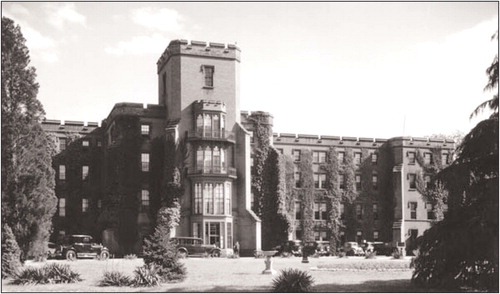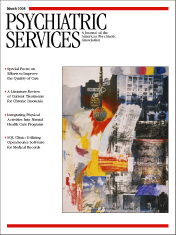Saint Elizabeths Hospital Celebrates 150th Anniversary
This year Saint Elizabeths Hospital is celebrating its 150th anniversary. The Washington, D.C., hospital occupies a unique place in the history of American psychiatry. It was founded by Dorothea Dix, the 19th century reformer, with the stated goal of providing "the most humane care and enlightened curative treatment of the insane of the Army, Navy, and the District of Columbia." When the doors of Center Building (pictured here) opened on January 15, 1855, Saint Elizabeths was the only federal government hospital for persons with mental illness. It played a prominent role in treating military personnel during the Civil War, the Spanish American War, World War I, and World War II. By the 1940s, the hospital housed 7,000 patients, and its campus encompassed more than 300 acres.
Saint Elizabeths has been a center for research and innovation in treatment and care. It has also been a major educational resource—a training site for psychiatrists, psychologists, and other health professionals that has attracted prominent members of these fields. The hospital's first five superintendents were elected president of the American Psychiatric Association and its predecessor organizations the Association of Medical Superintendents of American Institutions for the Insane and the American Medico-Psychological Association.
The hospital's first superintendent, Charles H. Nichols, M.D. (1852-1877), introduced innovations in hospital design and construction. The 1881 trial of presidential assassin Charles Guiteau, at which both Dr. Nichols and William W. Godding, M.D., the second superintendent (1877-1899) testified, marked the hospital's long and notable involvement in forensic psychiatry. After Guiteau was convicted and hanged, Dr. Godding attended Guiteau's autopsy. This event solidified Godding's belief in the importance of studying the effects of mental illness on the brain in order to understand and treat mental disorders. Consequently, in 1884 Godding hired Isaac W. Blackburn, M.D., who established the first pathology laboratory in a U.S. mental hospital. Under Dr. Godding the hospital also opened Howard Hall in l891, one of the early special facilities in the United States for the care and treatment of the criminal insane.
William Alanson White, M.D., the fourth superintendent (1903-1937) and a major figure in early 20th century psychiatry, ushered in the scientific era at Saint Elizabeths. In 1907 he established a psychology laboratory under Shepherd Ivory Franz, Ph.D., and the first psychotherapy department in a mental hospital under William Kempf, M.D. During the tenure of Winfred Overholser, M.D., the fifth superintendent (1937-1962), Saint Elizabeths expanded treatments to include psychodrama, art, and dance therapy. Dr. Overholser also developed a chaplaincy service that became a model for other psychiatric hospitals.
Luther Robinson, M.D. (acting superintendent, 1969-1972; superintendent, 1972-1975) was the hospital's first African-American superintendent. He developed one of the country's first treatment programs for mentally ill persons with hearing impairments and guided the hospital through many organizational and policy changes.
In 1987 Saint Elizabeths Hospital was transferred from the federal government to the District of Columbia. Today it is part of the city's Department of Mental Health. Under the leadership of Joy Holland, R.N., M.H.A., the first African-American woman to head the hospital, Saint Elizabeths is revitalizing its services to patients and its relationship with the community. The hospital is preparing to break ground for a new building that will combine clinical and forensic services.
Throughout 2005, the hospital will conduct a variety of activities to celebrate its 150th anniversary. A highlight will be a two-day educational symposium entitled "The Role of the Public Mental Health Hospital in the 21st Century," to be held on May 5 and 6, 2005, at the new Washington Convention Center. The symposium will feature nationally recognized leaders in the fields of clinical, research, administrative, and forensic psychiatry and will continue Saint Elizabeths' 150-year tradition of excellence in education as well as patient care and research. For more information about the symposium and other scheduled activities, contact Evone Butler at 202-645-8647.
SAMHSA Releases Revised and Updated Treatment Improvement Protocol on Co-occurring Disorders
In response to increasing evidence of the high prevalence of co-occurring disorders and the effectiveness of integrated treatment, the Substance Abuse and Mental Health Services Administration (SAMHSA) has revised and updated its Treatment Improvement Protocol (TIP) on co-occurring disorders. The TIP is designed for substance abuse treatment counselors and mental health care providers who usually treat one or the other of the two disorders, many of whom have come to realize that among individuals who seek treatment, a co-occurring disorder is the expectation, not the exception.
Prevalence data summarized in the TIP indicate that four million Americans have co-occurring serious mental and substance use disorders, a figure that does not take into account those with less severe disorders. From 50 to 75 percent of persons in substance abuse treatment programs have co-occurring mental illness, and 20 to 50 percent of those in mental health settings have a co-occurring substance use disorder. Although persons with co-occurring disorders are more likely to seek treatment, a 2002 survey of substance abuse treatment facilities found that fewer than half—about 49 percent—provided special programs or groups for persons with co-occurring mental illness. That figure was higher—63 percent—among the mental health facilities surveyed; however, the TIP notes that of the 1.36 million persons in treatment for substance use disorders in 2002, nearly 70 percent were in substance abuse treatment facilities.
The TIP describes advances in integrated treatment for co-occurring disorders with the goal of cross-training frontline clinicians in the substance abuse and mental health treatment systems. It contains nine chapters that address terminology, assessment, and treatment strategies and models as well as recommendations for research and policy planning. Strategies, techniques, and models presented in the TIP meet one of three criteria for inclusion: definitive research (evidence-based treatments), well-articulated approaches with empirical support, and consensus about established clinical practice. Case histories, illustrations, and summaries synthesize knowledge for practical application. "Advice to the Counselor" text boxes present the TIP's most direct and accessible guidance.
The chapter "Keys to Successful Programming" is organized around six guiding principles for treating individuals with co-occurring disorders: employ a recovery perspective; adopt a multiproblem viewpoint; develop a phased approach to treatment; address specific real-life problems early in treatment; plan for the client's cognitive and functional impairments; and use support systems to maintain and extend treatment effectiveness. Guidelines for assessing an agency's potential to serve this population address financing principles and how to secure federal, state, and private funds and attain equitable allocation of resources. A detailed section on workforce development describes basic, intermediate, and advanced clinician competencies and resources for training.
The chapter on treatment strategies begins with guidelines for forming a successful therapeutic alliance, with an emphasis on overcoming countertransference, maintaining a recovery perspective, and using an empathic style. Six key techniques are then detailed: motivational interviewing and enhancement consistent with the client's specific stage of change; contingency management to address target behaviors; cognitive-behavioral therapy adapted to the significant distortions in thinking commonly found among persons with co-occurring disorders; relapse prevention therapy focused on achieving a balanced lifestyle; repetition and skill building to address deficits in functioning; and facilitation of the client's participation in mutual self-help groups.
Another chapter provides an overview of specific mental disorders. This brief chapter is accompanied by a 100-page appendix that examines these and other disorders more closely. The major classes of psychotropic medications are described in another appendix, with sections on indications, dosage, potential side effects, and special considerations.
Each chapter of the TIP emphasizes the importance of thorough and ongoing assessment, and a separate chapter outlines a 12-step assessment process designed to obtain a detailed psychiatric and substance abuse history, to understand the client's current strengths and deficits, and to determine the client's stage of change for each problem. The appropriate use of screening and assessment instruments is addressed, and an appendix lists 17 such tools with information on their purpose, utility, and format.
The TIP was developed by a 19-member consensus panel of treatment providers and researchers co-chaired by Stanley Sacks, Ph.D., of the National Development and Research Institutes in New York City and Richard K. Ries, M.D., professor of psychiatry at the University of Washington. In its current loose-leaf format of 600 pages, the TIP is primarily for use as a training resource to ensure broad transfer and application of new findings. In the coming year, SAMHSA will create other documents based on the TIP's contents, including quick reference guides and toolkits. Substance Abuse Treatment for Persons With Co-occurring Disorders, TIP 42 in the SAMHSA series, is not yet posted on the SAMHSA Web site. It can be ordered free of charge from SAMHSA's National Clearinghouse for Alcohol and Drug Information at http://ncadi.samhsa.gov or by calling 1-800-729-6686.
Dr. Prandoni retired as deputy director of forensic services at Saint Elizabeths Hospital in 2004. Dr. Gold is clinical associate professor of psychiatry at Georgetown University Medical Center in Washington, D.C., and a member of the American Psychiatric Association's history and library committee.

.



